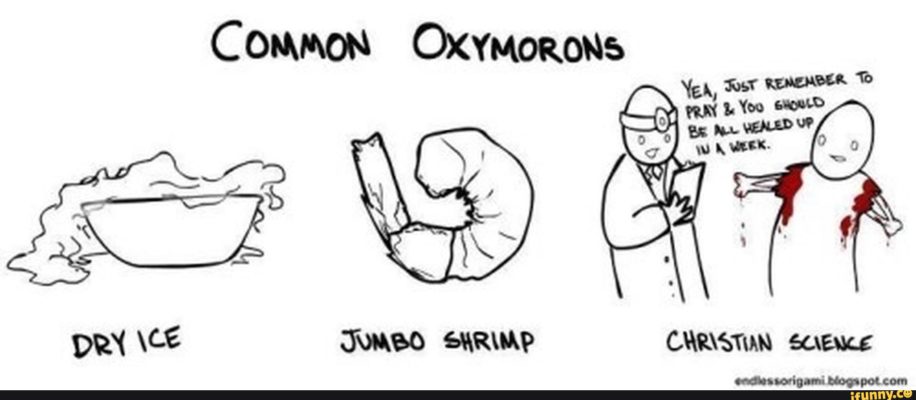Languages of the world are full of interesting linguistic phenomena that make people’s speech more colourful, and give linguists a lot of material to study. They make learning foreign languages a little harder, but also a lot more interesting! One-word oxymorons are one of these!
In this article, we will take a look at one such interesting phenomenon in the English language: oxymorons, and in particular, oxymorons consisting of a single word.
Definition of an oxymoron
Cambridge Dictionary defines an oxymoron as ‘two words used together that have, or seem to have, opposite meanings’. Merriam-Webster Dictionary gives a similar definition: ‘a combination of contradictory or incongruous words (such as ‘cruel kindness’)’.
And indeed, most common oxymorons are word combinations that consist of two words. Here are a few examples:
- Deafening silence
- Open secret
- Sad smile
- Act naturally
- Small crowd
- Original copy
However, an oxymoron can be much longer, as illustrated by these couple of famous quotes:
I can believe anything, provided that it is quite incredible.
Oscar Wilde
A business that makes nothing but money is a poor business.
Henry Ford
Or my personal favourite:
We’re busy doing nothing.
Bing Crosby
An oxymoron can also consist of just one word.
One-word oxymorons
A one-word oxymoron is a single word that somehow manages to contain two opposing or contrasting ideas. These are usually compound words that consist of two roots with very different meanings.
One of the most common examples of a one-word oxymoron is the word ‘bittersweet’. It brings together two contrasting tastes and is commonly used to describe an emotion that is pleasant but also comes from sadness, such as nostalgia for your childhood, for example.
Interestingly, the word ‘oxymoron’ is itself a one-word oxymoron. We may not recognize it as one as easily as in the previous example because the roots it is made up of are not English.
The word ‘oxymoron’ is derived from two ancient Greek roots: ‘oxys’ means ‘sharp, keen’, while ‘moronos’ means ‘dull, stupid’. The term was created by the Ancient Greeks to describe the figure of speech built on the contradiction of two opposing ideas.
Quite a few one-word oxymorons contain foreign roots. ‘Sophomore’, a student in the second year at college or a 4-year secondary school, also contains Greek roots: ‘sophos’ meaning ‘wise’ and ‘moros’ meaning ‘foolish’.
Here are a few other examples of one-word oxymorons:
- Spendthrift
- Pianoforte
- Chiaroscuro
- Superette
- Preposterous
Use of oxymorons
Oxymorons are a figure of speech and they have been used since ancient times. Many writers have used them. Oscar Wilde loved oxymorons for their paradoxical effect. William Shakespeare used a lot of oxymorons in his works, Romeo and Juliet in particular:
O brawling love! O loving hate!
Act 1, Scene 1 — Romeo and Juliet, William Shakespeare
Oh anything of nothing first create!
O heavy lightness, serious vanity!
Misshapen chaos of well-seeming forms!
Feather of lead, bright smoke, cold fire, sick health!
Still-waking sleep, that is not what it is!
This love feel I, that feel no love in this.
In general, writers and speakers use oxymorons to add flavour to their speech or writing. Oxymorons can create a dramatic effect by drawing the reader’s or listener’s attention to the object, highlighting that it can have two opposite qualities, like a silence so deep it is deafening. They can also create a humorous effect, showcase the speaker’s wit, and make people laugh.
We use some oxymorons so often that they have become a part of everyday speech. We use words and phrases like ‘sophomore’ or ‘plastic glass’ having forgotten the internal contrast that is contained inside.
_______________________
If you enjoyed this article, you may also like:

